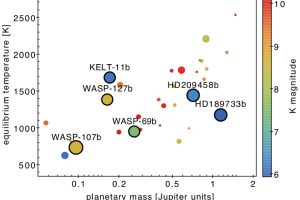Five molecular species found in the atmosphere of WASP-69b. The study: “The GAPS Programme at TNG. XXXVIII. Five molecules in the atmosphere of the warm giant planet WASP-69b detected at high spectral resolution” of G. Guilluy (INAF-OATo) recently appeared on A&A

In recent years, advances in instrumentation, knowledge, and observational strategies in the field of exoplanets have allowed for the identification and confirmation of thousands of planets around other stars (exoplanets). Moreover, for the past few years, astronomers have been capable of studying the chemistry and physical properties of the atmospheres of some of these exotic worlds. These studies can also provide crucial information on how planets form by accreting solids and gas from the protoplanetary disk, which are disks around young stars where planets form, as well as on the radial migration of planets from their formation sites.
One of the main projects aimed at characterizing exoplanets is GAPS (Global Architecture of Planetary Systems), which is mainly based on observations with the spectrometers HARPS-N in the optical and GIANO-B in the infrared bands, both mounted on the Telescopio Nazionale Galileo. The planets observed within the framework of GAPS include 26 hot Jupiters (gas giants with an orbital period of <10 days) and four hot Neptunians and sub-Neptunians, with temperatures ranging from 625 to 2500 degrees. These planets orbit stars with spectral classes from A to M.
One of the GAPS targets is the planet WASP-69b, which orbits a K5V star. WASP-69b is a gas giant, and previous observations have identified the presence of water and sodium in its atmosphere. The team of researchers, led by astronomer G. Guilluy (INAF – Astrophysical Observatory of Turin), analyzed GIANO-B and HARPS-N observations of WASP-69b acquired during the planet transits on July 24th, 2019, August 9th, 2020, and October 28th, 2021. From this analysis, the team identified five molecular species in the exoplanet’s atmosphere: methan (CH4), ammonia (NH3), carbon monoxide (CO), acetylene (C2H2) and water (H2O). This is the second case in which such a rich chemistry has been found in the atmosphere of an exoplanet. By coupling these observations with theoretical models of the atmosphere of WASP-69b, the authors concluded that this atmosphere is likely characterized by a C/O ratio (which is the ratio between the abundance of carbon over oxygen) greater than 1 and a metallicity (which is the abundance of heavy elements of hydrogen) of solar type. By comparing these estimates with precise measurements of the metallicity of the parent star (WASP-69), the team suggested that the planet formed in a gas-rich environment where it accreted few solids. The study is described in the paper: “The GAPS Programme at TNG XXXVIII: Five molecules in the atmosphere of the warm giant planet WASP-69b detected at high spectral resolution“, recently published in the journal Astronomy & Astrophysics. Among the coauthors, are the astronomers A. Maggio and G. Micela of INAF – Astronomical Observatory of Palermo.
The figure (click here to visualize the entire image) shows the values of equilibrium temperature and mass of the planets included in the GAPS program.
Mario Giuseppe Guarcello ( follow mariospiegacose) ( mariospiegacose) ( follow mariospiegacose)
Follow the Astronomical Observatory of Palermo on Facebok
Subscribe the Youtube channel of the Astronomical Observatory of Palermo
